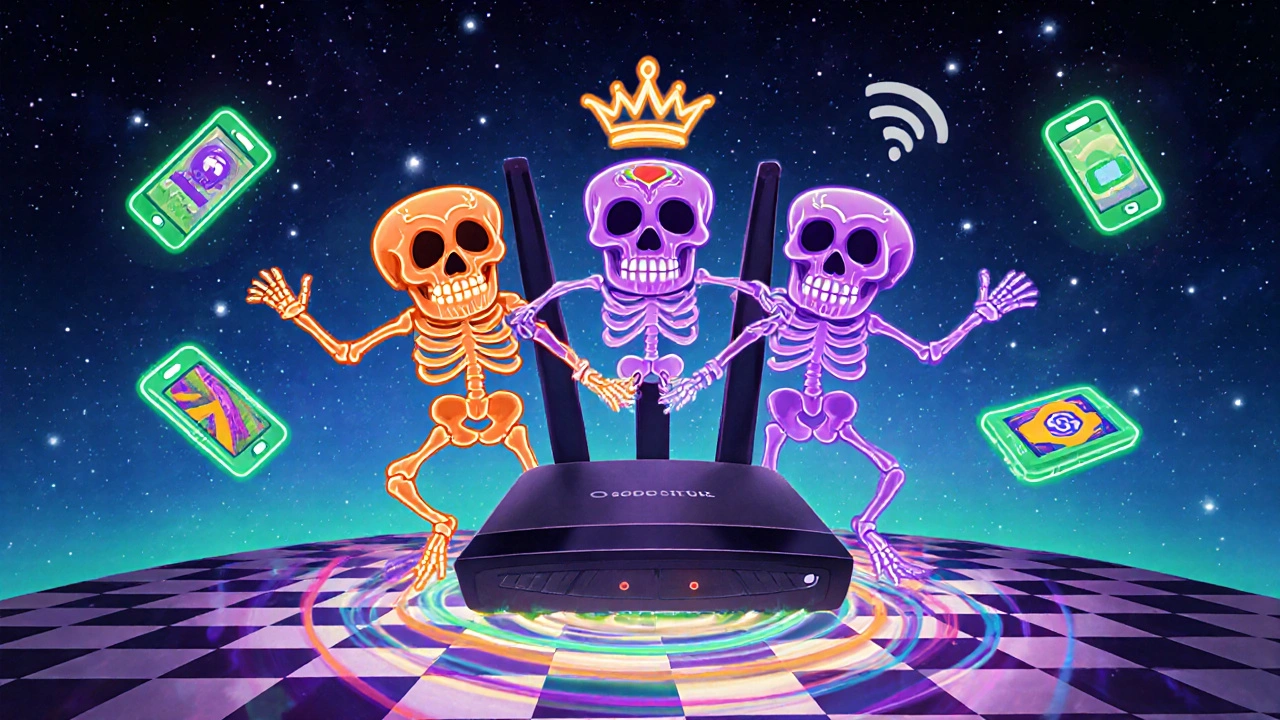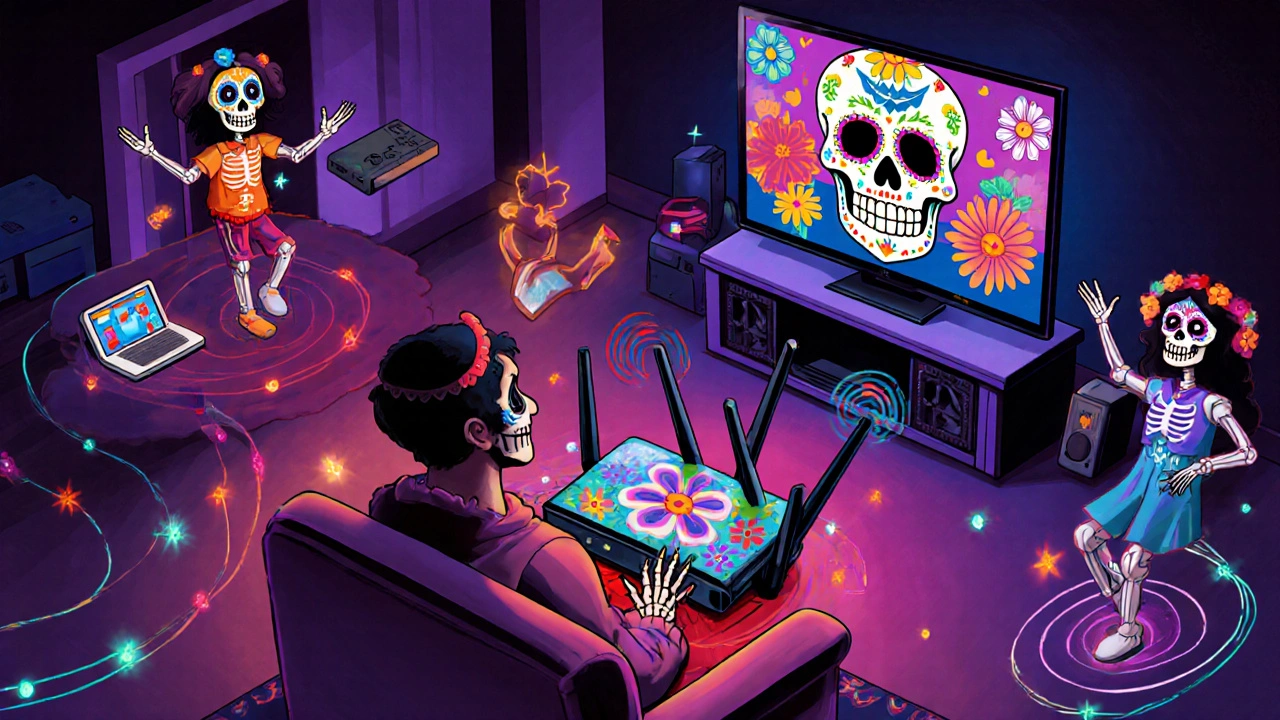You’ve bought the 4K TV, subscribed to Netflix and Disney+, and even got the soundbar that makes your living room feel like a cinema. But every time you hit play, the buffer wheel spins. The picture freezes. The audio cuts out. It’s not your streaming service-it’s your router. Most people don’t realize that a basic single-band router can’t handle 4K streaming, especially when multiple devices are connected. If you’re still using a router from 2018 or earlier, you’re fighting a losing battle. The solution isn’t more bandwidth from your ISP-it’s upgrading to a dual-band or tri-band router and setting it up right.
Why Your Current Router Fails at 4K Streaming
4K video needs at least 25 Mbps of stable bandwidth. But that’s just the start. A single 2.4 GHz band router, common in older models, struggles with interference from microwaves, baby monitors, and even Bluetooth speakers. It’s slow, congested, and unreliable. Even if your internet plan gives you 100 Mbps, your router might only deliver 15 Mbps over 2.4 GHz. That’s not enough for 4K-it’s barely enough for HD.
Worse, most households now have 10+ devices connected: smartphones, tablets, smart TVs, laptops, smart fridges, gaming consoles, and security cameras. All of them compete for the same tiny wireless channel. One person video calling on Zoom while someone else streams 4K? That’s a recipe for constant buffering.
Enter dual-band and tri-band routers. They don’t just give you more speed-they give you more space. Think of it like adding lanes to a highway. More lanes mean less traffic, fewer delays, and smoother rides.
Dual-Band vs Tri-Band: What’s the Difference?
Dual-band routers broadcast on two frequencies: 2.4 GHz and 5 GHz. The 2.4 GHz band travels farther and goes through walls better, but it’s slower and crowded. The 5 GHz band is faster, cleaner, and ideal for streaming, but it doesn’t reach as far. Most modern devices automatically connect to the best band, but you can also manually assign them.
Tri-band routers add a second 5 GHz band. That’s three networks total: one 2.4 GHz and two 5 GHz. Why two 5 GHz bands? Because they let you separate heavy traffic. You can put your TV, gaming console, and laptop on one 5 GHz band, and your phone, tablet, and smart home gadgets on the other. No more competition. No more lag.
In Auckland, where homes are often compact but packed with smart devices, tri-band routers make a real difference. A study by Telecom NZ in 2024 showed households using tri-band routers had 68% fewer buffering incidents during peak evening hours compared to those on dual-band setups.
What to Look for in a Router for 4K Streaming
Not all dual-band or tri-band routers are created equal. Here’s what actually matters:
- Wi-Fi 6 (802.11ax) - Older Wi-Fi 5 (802.11ac) routers are outdated. Wi-Fi 6 handles more devices at once and reduces latency. It’s not just faster-it’s smarter.
- Four or more antennas - More antennas mean better signal coverage. Look for routers with external antennas, not hidden ones.
- Quality of Service (QoS) - This lets you prioritize streaming devices. Set your TV as the top priority, and the router will give it more bandwidth when needed.
- 1 Gbps Ethernet ports - If you’re connecting your TV or gaming console via cable, make sure the router has Gigabit Ethernet. Avoid routers with only 100 Mbps ports.
- Mesh-ready - Even the best router can’t fix dead zones in a large home. If your place is over 150 square meters, consider a mesh system with a tri-band backhaul.
Brands like TP-Link Archer AXE5400, ASUS RT-AX86U, and Netgear Nighthawk RAX50 are reliable choices. They’re all Wi-Fi 6, tri-band, and include QoS. Avoid no-name brands. They might be cheaper, but they often lack firmware updates, which means security holes and poor performance over time.

Step-by-Step Setup for 4K Streaming
Buying the right router is only half the battle. Setup matters just as much.
- Unplug your old router. Wait 30 seconds, then disconnect all cables.
- Connect the new router to your modem. Use the Ethernet cable that came with the router. Plug it into the WAN port (usually yellow or labeled differently).
- Power on the router. Wait 2-3 minutes for it to boot up.
- Access the admin panel. Open a browser and type the router’s IP address (usually 192.168.1.1 or 192.168.0.1). Check the label on the router for the exact address.
- Change the default password. Never skip this. Default passwords are easy to hack.
- Set up dual-band or tri-band networks. Give each band a unique name. For example:
- Home_2.4GHz
- Home_5GHz_1
- Home_5GHz_2
- Enable QoS. Go to the QoS settings and set your TV or streaming box as the highest priority device. If your router shows devices by name, select your Samsung TV or Apple TV. If it shows MAC addresses, find your device’s address in its network settings and enter it manually.
- Connect your 4K devices to the 5 GHz band. On your TV, go to Wi-Fi settings and manually connect to Home_5GHz_1. Do the same for your gaming console or streaming stick. Don’t rely on auto-connect.
- Test your speed. Use the Speedtest app on your phone or computer while connected to the 5 GHz network. You should see speeds above 80 Mbps. If you’re under 50 Mbps, check your ISP plan or try a different channel in the router settings.
Common Mistakes That Ruin 4K Streaming
Even with a great router, people mess up setup in simple ways:
- Leaving devices on 2.4 GHz - Your phone might be stuck on the slow band because it’s “closer.” Manually switch it to 5 GHz.
- Using the same name for all bands - If all networks are called “HomeWiFi,” your devices jump between them randomly. Give each band a unique name so you can control where each device connects.
- Ignoring firmware updates - Outdated firmware causes crashes and slowdowns. Set your router to auto-update.
- Placing the router on the floor - Put it on a shelf, near the center of your home. Avoid metal objects, mirrors, or thick walls. A router on the floor is like a lighthouse buried underground.
- Forgetting wired connections - If your TV has an Ethernet port, use it. A wired connection is 100% stable. No buffering. No drops.

When You Need a Mesh System Instead
If your home is over 200 square meters, or you have thick concrete walls, even the best single router won’t cover everything. That’s when you need a mesh system.
Tri-band mesh systems (like TP-Link Deco XE75 or Netgear Orbi RBK752) use one 5 GHz band for communication between nodes and the other for your devices. This keeps the backhaul fast and avoids congestion. You’ll get consistent 4K streaming in every room-even the basement.
For Auckland homes with brick walls and large open-plan layouts, mesh systems are no longer optional. They’re the standard.
Final Tip: Test Before You Buy
Before spending $400 on a router, borrow one from a friend or rent from a local tech shop. Test it for a week with your exact setup: same TV, same streaming apps, same number of devices. If the buffering stops, you know you’re buying the right thing.
Don’t upgrade just because it’s new. Upgrade because it solves your problem. A $150 dual-band Wi-Fi 6 router can outperform a $500 older tri-band model if it’s set up right. Focus on performance, not specs.
Frequently Asked Questions
Do I need a tri-band router for 4K streaming?
Not always. A good dual-band Wi-Fi 6 router is enough for most households with 5-7 devices. But if you have more than 10 connected devices, or you stream 4K on multiple TVs at once, a tri-band router gives you breathing room and prevents slowdowns.
Can I use a 2.4 GHz band for 4K streaming?
Technically yes, but you shouldn’t. 2.4 GHz is slow, crowded, and prone to interference. Even if you get 25 Mbps, the connection will be unstable. Buffering will happen. Always connect 4K devices to the 5 GHz band.
Why is my 4K stream still buffering even with a new router?
Check your internet plan. You need at least 50 Mbps for one 4K stream, and 100+ Mbps if multiple people are streaming. Also, make sure your TV or streaming box is connected to the 5 GHz network, not 2.4 GHz. Use Ethernet if possible. And update your router’s firmware.
Should I buy a router with built-in modem?
Only if your ISP requires it. Most New Zealand ISPs provide a separate modem. Using a combo unit can limit your options and make troubleshooting harder. Stick with a standalone router and modem unless you’re sure the combo is approved by your provider.
How often should I replace my router?
Every 3-5 years. Wi-Fi standards improve fast. A router from 2020 might still work, but it won’t handle new devices or higher speeds efficiently. If you notice frequent drops, slow speeds, or overheating, it’s time to upgrade-even if it’s not broken.


